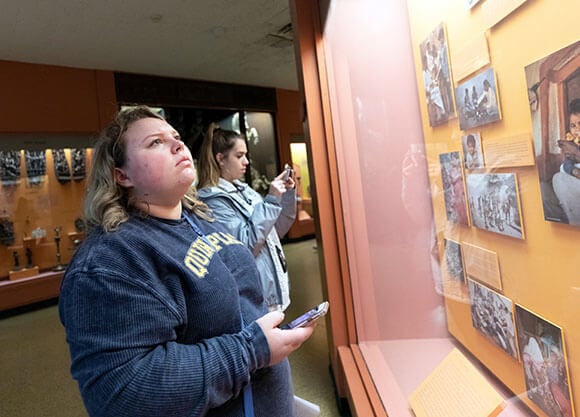
History-anthropology cluster course helps student develop holistic world view
March 23, 2019

March 23, 2019

From the moment she arrived at Quinnipiac, Rachel Houlihan ‘22 knew she wanted to study history.
The idea of a world-sized classroom, where students develop a sophisticated view of their planet with enriched classes and off-campus opportunities, really appealed to her.
As part of this strategy, Houlihan and other first year history majors took a cluster course last fall pairing world history taught by Associate Professor Nita Prasad and cultural anthropology taught by Professor Hillary Haldane.
The College of Arts and Sciences created the pilot program a few years ago, Senior Associate Dean Mary Paddock said. The world history and cultural anthropology classes are among the more than 60 intercultural understanding courses — I Courses, for short — available in the University Curriculum.
“When you’re taking two courses together like that, it can be a little tricky sometimes,” said Houlihan.
“Professor Haldane and Professor Prasad were both excellent in aligning things. We would learn something on Monday in anthropology and on Tuesday in history, it all clicked.”
The structure of the I Course not only gave Rachel a deeper understanding of history, but also deeper connections with her classmates.
The curriculum, spread across five classes each week, has emerged as thoughtful, deliberate and engaging, a novel approach to teaching students what it means to be global citizens in the 21st century.
“When you’re learning with people and bouncing ideas off them five days a week, you create a bond with them,” Houlihan said. “I know for me as a first-year student, getting to know other students and delving deeper into something I’m really interested in meant a lot.”
Some of the cultures featured in the integrated course were the Malians from West Africa, the Haitians, the Triqui [indigenous Mexicans] and the Trobriand Islanders off the eastern coast of New Guinea.
“When you combine history and anthropology together like we did, it’s more like, ‘How are we as outsiders looking in on other cultures and other people? And what is our perspective on that?’ I learned so much taking the two classes together in terms of developing my view of the world,” Houlihan said.
By teaching these lessons in a shared context, Haldane explained, students learn from the past as well as from cultures and societies around the world. This approach helps students better address universal issues such as racism, climate change and violence against women.
“We cannot solve the immense problems facing our society and others across the planet if we continue to teach a parochial and ethnocentric curriculum,” said Haldane, who is also director of the anthropology program. “The history-anthropology cluster is one small step toward moving us in a more globally minded, historically grounded direction.”
Rachel's class took a trip together to the Natural History Museum in New York City to use the knowledge they gained through the I Course to examine portrayals of cultures in the museum's exhibits.
For the course’s capstone project, students visited the American Museum of Natural History in New York City to develop a poster based on cultural portrayals in the museum’s exhibits. Houlihan’s poster examined the people of India and how Hinduism and Islam affect their interactions and coexistence.
“I learned that the pairing of anthropology and history is important because you need that empathetic lens to really understand and appreciate other cultures,” Houlihan said.
In December, the students displayed their posters and held a mini-conference at the Carl Hansen Student Center. The capstone projects were reviewed by Mark A. Thompson, executive vice president and provost, and Don C. Sawyer III, associate vice president for academic affairs and chief diversity officer.
Haldane said she was pleased with Houlihan’s commitment to the coursework and her education.
“Rachel is an ideal Quinnipiac student: curious, driven, open-minded, communally engaged and an empathetic listener,” Haldane said. “She has a career goal in mind (as a high school history teacher) but wants as broad a general education as possible to make sure the next generation of high school students learn in holistic ways.”
Quinnipiac Today is your source for what's happening throughout #BobcatNation. Sign up for our weekly email newsletter to be among the first to know about news, events and members of our Bobcat family who are making a positive difference in our world.
Sign Up Now